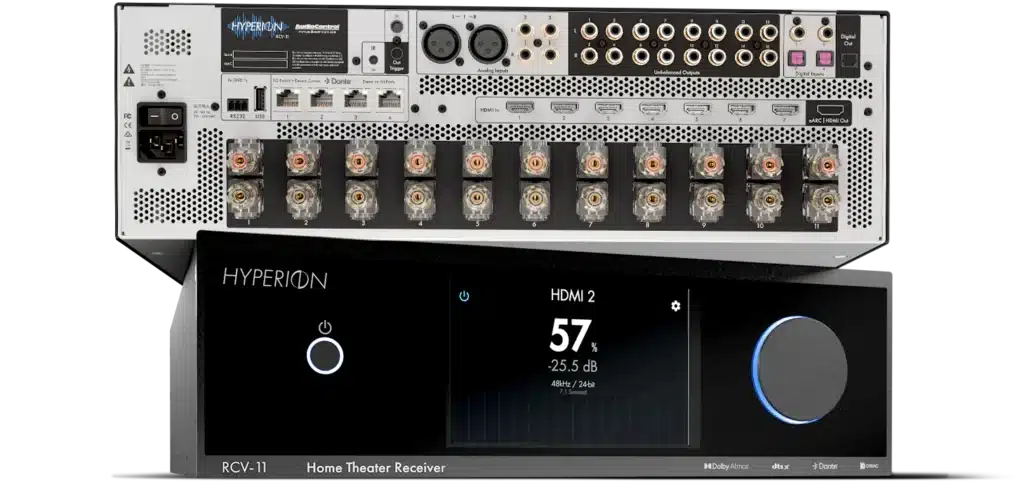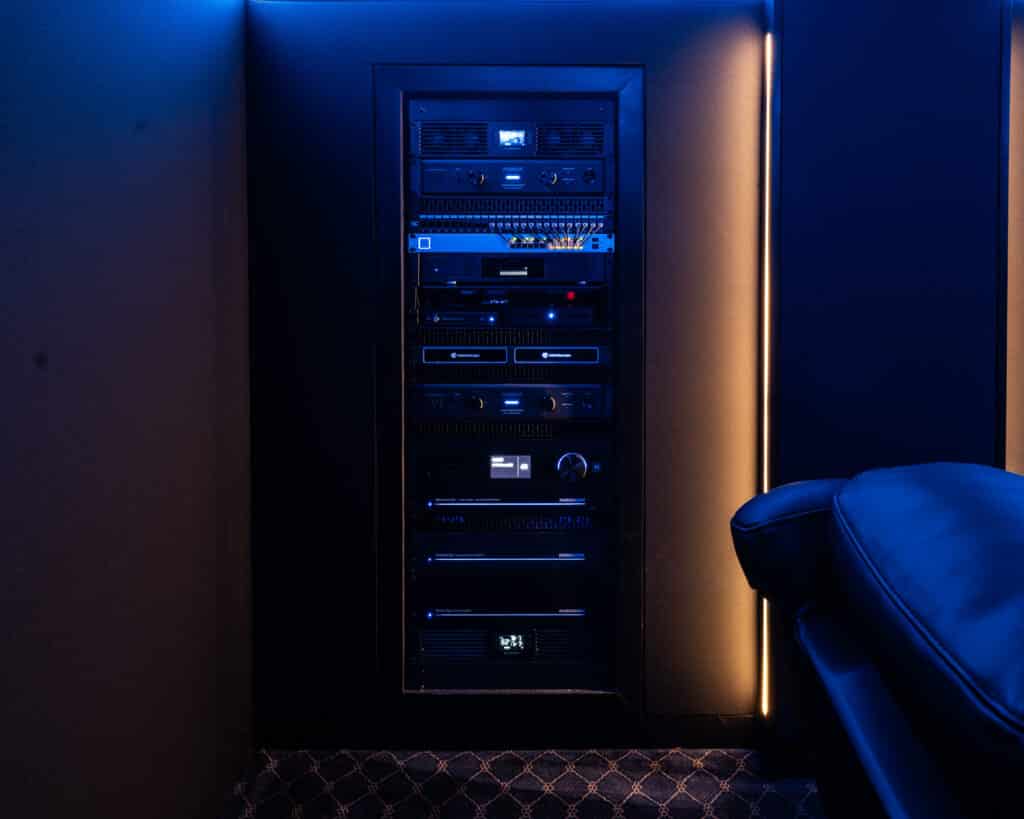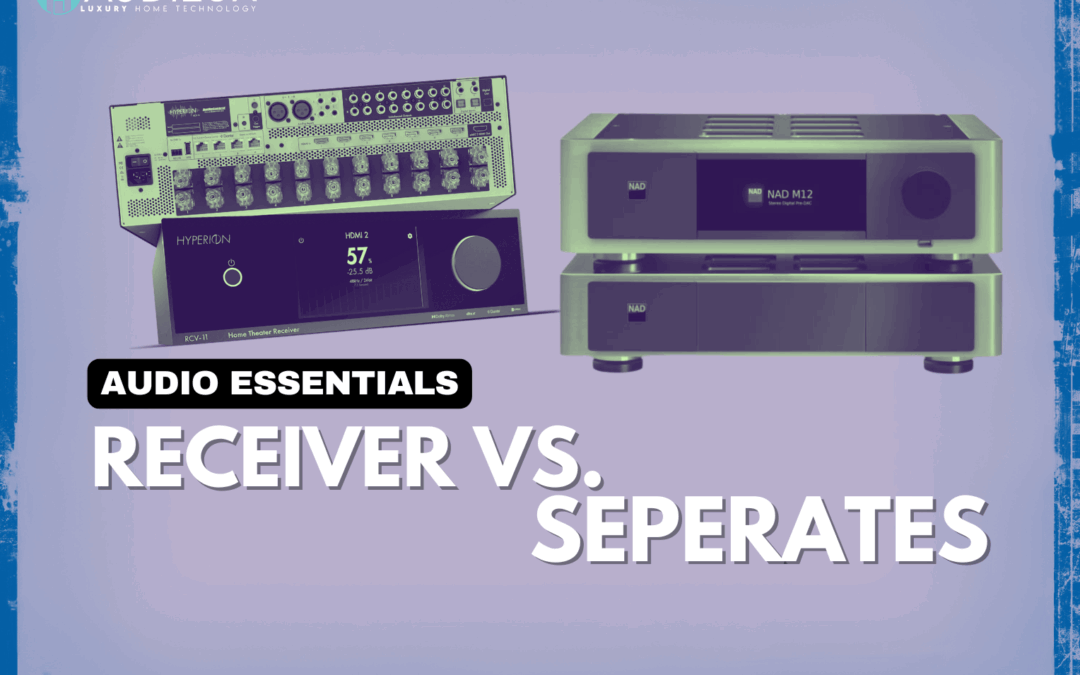TL:DR – AV Receivers are an affordable gateway into the world of audio and home theater. Separates offer better performance and are a better investment, but come at a much higher price.
Understanding AV Receivers: The All-in-One Solution
Receivers can be looked at as an all-in-one solution for simpler home theater or music setups. This is what you’re used to seeing when you walk into any big box store. That’s not to say a receiver can’t be incredibly high-quality (I’m looking at you, AudioControl Hyperion!), but they’re definitely more prevalent in lower complexity setups.

A receiver includes two major parts. The first part is a processor or pre-amp. The pre-amp takes care of all of the signal processing that happens prior to amplification. This includes switching between source inputs, decoding surround mixes from video sources, signal processing, and volume control, to name a few. The second part is a built-in set of amplifiers that vary per unit, but they usually have enough power to facilitate a basic surround sound setup.
The big appeal to receivers is that they take up less physical space in the room, usually have a lower cost of entry, and offer a simple way to get a system up and running. This integrated approach has a few limitations, though. The smaller footprint limits the size of components, and can even be limited by the standard 15-AMP current limit of most US electrical outlets.[1]
The Truth About Separates: Unlocking Peak Performance
Most budding audiophiles immediately drift to dreams of separate dedicated AV Processors and Amplifiers when visualizing their dream audio setup. [2]

The real reason for the performance leap has more to do with real estate inside of the case than you might think. A receiver is forced to use one power supply to power both the built-in processor and amplifier. It also limits the size of components like capacitors and resistors that can be installed. Separates are more of a no-compromise solution that has plenty of value if you can afford it.
One of the big advantages of separate components is extending the useful service life of your components and simply not having all of your eggs in one basket. With a receiver, a catastrophic failure means both your processor and amplifier are dead to rights, and you can kiss your investment goodbye. Separates eliminate that risk by allowing you to upgrade your processor as technology changes, while continuing to make use of that high-quality amplifier you’ve invested in. This modularity is a key benefit for long-term system planning.[3]
AV Receivers vs. Separates: A Comparative Look
To help you make an informed decision, let’s break down the key differences between AV receivers and separates:
| Feature | AV Receiver | Separates (Processor + Amplifier) |
|---|---|---|
| Cost of Entry | Lower | Significantly Higher |
| Performance Potential | Good for most users, can be limited by integrated design | Higher, due to dedicated components and power supplies |
| Space Efficiency | High (all-in-one unit) | Lower (multiple components) |
| Upgradeability | Limited (entire unit must be replaced) | High (individual components can be upgraded) |
| Power Supply | Shared for processor and amplifier | Dedicated for each component |
| Component Size Limitations | Yes, due to chassis size and power constraints | No, larger, higher-quality components can be used |
| Risk of Catastrophic Failure | Higher (failure of one part affects the whole unit) | Lower (failure of one component doesn’t affect others) |
Which Path is Right for You?
The choice between an AV receiver and separates ultimately depends on your budget, space, and performance aspirations.
- For the budget-conscious and space-limited: An AV receiver offers an excellent balance of features and performance for most home theater enthusiasts. It’s a fantastic starting point to enjoy immersive sound without breaking the bank.
- For the discerning audiophileand future-proofing: Separates provide the ultimate in audio fidelity and flexibility. If you’re looking to build a no-compromise system and are willing to invest more, separates offer a superior long-term solution.
Still Unsure About the Best Path for Your Home Theater?
Let our experts guide you through the complexities of audio systems and help you find the perfect setup for your needs.
References
“The Benefits of Modular Audio Systems.” Audio Engineering Society Journal, vol. 65, no. 10, 2017, pp. 801-809.
“Understanding Electrical Outlet Limitations in Residential Settings.” National Electrical Code Handbook, 2020 ed.
Toole, Floyd E. Sound Reproduction: The Acoustics and Psychoacoustics of Loudspeakers and Rooms. Focal Press, 2017.
1. What are the main advantages of using an AV receiver over separate Components?
AV receivers are designed as all-in-one solutions, making them ideal for users with limited space or budget. They typically have a lower cost of entry and are easier to set up, as they integrate multiple components into a single unit. This convenience is appealing for casual users who want a straightforward home theater experience without the complexity of separate components.
Is the Upgrade to Seperates worth it?
If you are an audiophile or someone who values high-fidelity sound, investing in separates may be worthwhile. Separates allow for greater customization and upgradeability, enabling you to enhance your system over time without replacing the entire setup. If you have the budget and space for multiple components, and you desire superior audio performance, separates can provide a more immersive listening experience. Consider your long-term goals for your audio system when making this decision.
Can I use an AV Receiver for a High end audio setup?
Absolutely! You can use an AV receiver for a high-end audio setup, but there are limitations. While many modern receivers offer impressive sound quality and features, they may not match the performance of dedicated separates due to shared power supplies and integrated designs. If you prioritize convenience and cost-effectiveness, a high-quality AV receiver can still deliver excellent audio. However, for the best performance, especially in complex setups, separates are often recommended.
What should I consider when choosing between a Receiver & SeperateS?
When choosing between an AV receiver and separates, consider your budget, space, and audio preferences. Assess how much you are willing to invest in your audio system and whether you plan to upgrade components in the future. Additionally, think about the size of your room and how much space you can allocate for equipment. If you want a simple, compact solution, an AV receiver may be best. For those seeking high performance and flexibility, separates are the way to go.
Are there any downsides to using seperates?
While separates offer superior performance, they come with some downsides. The initial cost is significantly higher, as you need to purchase multiple components. Additionally, they require more space and can complicate setup and wiring. Really though, the only major downside is cost.
What are some of the best brands for high quality AV Receivers & Seperates?
NAD, AudioControl, and Marantz to name a few. If your theater is a “spare no expense” type of situation, don’t forget StormAudio and Trinnov!

